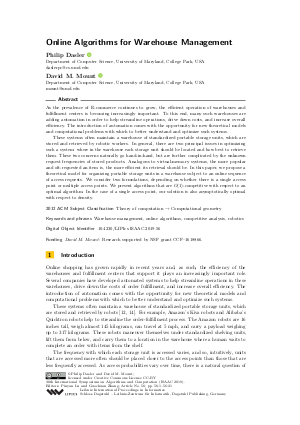Online Algorithms for Warehouse Management
Authors
Philip Dasler  ,
David M. Mount
,
David M. Mount 
-
Part of:
Volume:
30th International Symposium on Algorithms and Computation (ISAAC 2019)
Part of: Series: Leibniz International Proceedings in Informatics (LIPIcs)
Part of: Conference: International Symposium on Algorithms and Computation (ISAAC) - License:
 Creative Commons Attribution 3.0 Unported license
Creative Commons Attribution 3.0 Unported license
- Publication Date: 2019-11-28
File

PDF
LIPIcs.ISAAC.2019.56.pdf
- Filesize: 0.88 MB
- 21 pages
Document Identifiers
Subject Classification
ACM Subject Classification
- Theory of computation → Computational geometry
Keywords
- Warehouse management
- online algorithms
- competitive analysis
- robotics
Metrics
- Access Statistics
-
Total Accesses (updated on a weekly basis)
0PDF Downloads0Metadata Views
Abstract
As the prevalence of E-commerce continues to grow, the efficient operation of warehouses and fulfillment centers is becoming increasingly important. To this end, many such warehouses are adding automation in order to help streamline operations, drive down costs, and increase overall efficiency. The introduction of automation comes with the opportunity for new theoretical models and computational problems with which to better understand and optimize such systems. These systems often maintain a warehouse of standardized portable storage units, which are stored and retrieved by robotic workers. In general, there are two principal issues in optimizing such a system: where in the warehouse each storage unit should be located and how best to retrieve them. These two concerns naturally go hand-in-hand, but are further complicated by the unknown request frequencies of stored products. Analogous to virtual-memory systems, the more popular and oft-requested an item is, the more efficient its retrieval should be. In this paper, we propose a theoretical model for organizing portable storage units in a warehouse subject to an online sequence of access requests. We consider two formulations, depending on whether there is a single access point or multiple access points. We present algorithms that are O(1)-competitive with respect to an optimal algorithm. In the case of a single access point, our solution is also asymptotically optimal with respect to density.
Cite As Get BibTex
Philip Dasler and David M. Mount. Online Algorithms for Warehouse Management. In 30th International Symposium on Algorithms and Computation (ISAAC 2019). Leibniz International Proceedings in Informatics (LIPIcs), Volume 149, pp. 56:1-56:21, Schloss Dagstuhl – Leibniz-Zentrum für Informatik (2019)
https://doi.org/10.4230/LIPIcs.ISAAC.2019.56
BibTex
@InProceedings{dasler_et_al:LIPIcs.ISAAC.2019.56,
author = {Dasler, Philip and Mount, David M.},
title = {{Online Algorithms for Warehouse Management}},
booktitle = {30th International Symposium on Algorithms and Computation (ISAAC 2019)},
pages = {56:1--56:21},
series = {Leibniz International Proceedings in Informatics (LIPIcs)},
ISBN = {978-3-95977-130-6},
ISSN = {1868-8969},
year = {2019},
volume = {149},
editor = {Lu, Pinyan and Zhang, Guochuan},
publisher = {Schloss Dagstuhl -- Leibniz-Zentrum f{\"u}r Informatik},
address = {Dagstuhl, Germany},
URL = {https://drops.dagstuhl.de/entities/document/10.4230/LIPIcs.ISAAC.2019.56},
URN = {urn:nbn:de:0030-drops-115526},
doi = {10.4230/LIPIcs.ISAAC.2019.56},
annote = {Keywords: Warehouse management, online algorithms, competitive analysis, robotics}
}
Author Details
Funding
- Mount, David M.: Research supported by NSF grant CCF - 1618866.
References
- A. Aggarwal, B. Alpern, A. Chandra, and M. Snir. A Model for Hierarchical Memory. In Proc. 19th Annu. ACM Sympos. Theory Comput., STOC '87, pages 305-314, New York, NY, 1987. ACM. URL: https://doi.org/10.1145/28395.28428.
- F. Amato, F. Basile, C. Carbone, and P. Chiacchio. An approach to control automated warehouse systems. Control Eng. Pract., 13(10):1223-1241, October 2005. URL: https://doi.org/10.1016/j.conengprac.2004.10.017.
- A. S. Cahn. The summer meeting in Madison. Bull. Amer. Math. Soc., 54(11):1073, November 1948. URL: https://doi.org/10.1090/S0002-9904-1948-09093-0.
- M. Çelik and H. Süral. Order picking in a parallel-aisle warehouse with turn penalties. Internat. J. Production Res., 54(14):4340-4355, July 2016. URL: https://doi.org/10.1080/00207543.2016.1154624.
- F.-L. Chang, Z.-X. Liu, Z. Xin, and D.-D. Liu. Research on Order Picking Optimization Problem of Automated Warehouse. Sys. Eng. - Theory & Pract., 27(2):139-143, February 2007. URL: https://doi.org/10.1016/S1874-8651(08)60015-0.
- A. Charnes and W. W. Cooper. Generalizations of the Warehousing Model. OR: Oper. Research Quarterly, 6(4):131-172, 1955. URL: https://doi.org/10.2307/3006550.
- J.-F. Cordeau and G. Laporte. The dial-a-ride problem: Models and algorithms. Ann. Oper. Res., 153(1):29-46, 2007. URL: https://doi.org/10.1007/s10479-007-0170-8.
- S. P. Fekete and H.-F. Hoffmann. Online Square-into-Square Packing. Algorithmica, 77(3):867-901, 2017. URL: https://doi.org/10.1007/s00453-016-0114-2.
- S. P. Fekete., J.-M. Reinhardt, and C. Scheffer. An Efficient Data Structure for Dynamic Two-dimensional Reconfiguration. J. Syst. Archit., 75(C):15-25, April 2017. URL: https://doi.org/10.1016/j.sysarc.2017.02.004.
- R. A. Hearn and E. D. Demaine. PSPACE-completeness of sliding-block puzzles and other problems through the nondeterministic constraint logic model of computation. Theo. Comp. Sci., 343(1-2):72-96, 2005. URL: https://doi.org/10.1016/j.tcs.2005.05.008.
- J. E. Hopcroft, J. T. Schwartz, and M. Sharir. On the Complexity of Motion Planning for Multiple Independent Objects: PSPACE-Hardness of the "Warehouseman’s Problem". Internat. J. Robotics Res., 3(4):76-88, 1984. URL: https://doi.org/10.1177/027836498400300405.
-
D. Jain. Adoption of next generation robotics: A case study on Amazon. Perspectiva: A Case Research Journal, III:15, 2017.

- Elias Koutsoupias. The k-server problem. Computer Science Review, 3(2):105-118, 2009. URL: https://doi.org/10.1016/j.cosrev.2009.04.002.
-
C. K. M. Lee. Development of an Industrial Internet of Things (IIoT) based Smart Robotic Warehouse Management System. In CONF-IRM 2018 Proceedings, page 14, 2018.

-
R. B. Nelsen. Proofs without words: Exercises in visual thinking. Number no. 1 in Classroom resource materials. The Mathematical Association of America, Washington, D.C, 1993.

- K.-W. Pang and H.-L. Chang. Data mining-based algorithm for storage location assignment in a randomised warehouse. Internat. J. Production Res., 55(14):4035-4052, July 2017. URL: https://doi.org/10.1080/00207543.2016.1244615.
- M. Sarrafzadeh and S. R. Maddila. Discrete warehouse problem. Theo. Comp. Sci., 140(2):231-247, April 1995. URL: https://doi.org/10.1016/0304-3975(94)00192-L.
- R. Sharma and Y. Aloimonos. Coordinated motion planning: The warehouseman’s problem with constraints on free space. IEEE Transactions on Systems, Man, and Cybernetics, 22(1):130-141, February 1992. URL: https://doi.org/10.1109/21.141317.
- D. D. Sleator and R. E. Tarjan. Amorized Eficiency of List Update and Paging Rules. Commun. ACM, 28(2):202-208, February 1985. URL: https://doi.org/10.1145/2786.2793.
- L. Wolsey and H. Yaman. Convex hull results for the warehouse problem. Disc. Optimization, 30:108-120, 2018. URL: https://doi.org/10.1016/j.disopt.2018.06.002.
